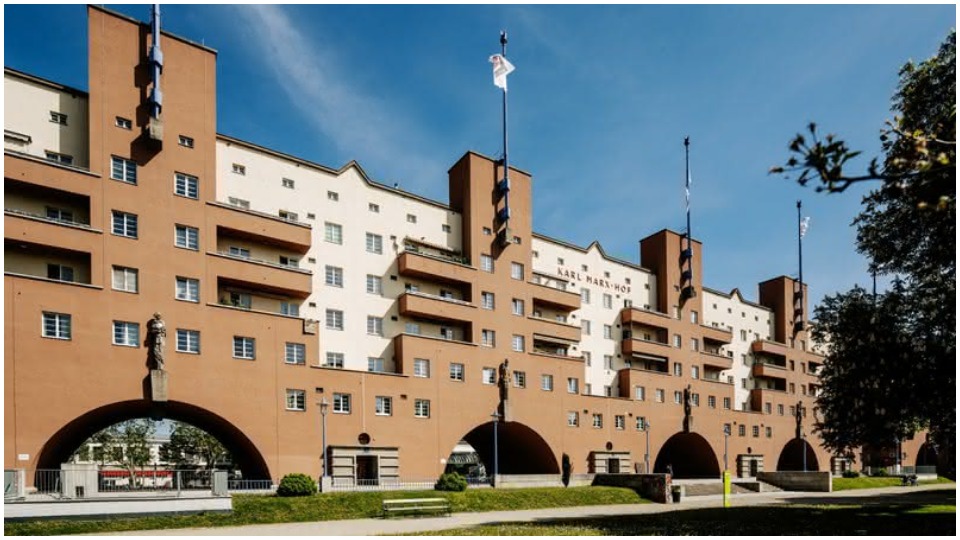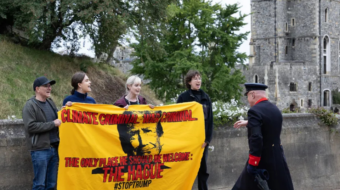
Europe’s zero interest rate is being used to further hollow out its major cities as those with capital in places such as Munich, Berlin, Paris and Amsterdam are borrowing at no cost and buying up apartments that are then being used as tourist rentals in partnership with Airbnb and other services. Along with this trend go steadily rising rents, which means that working and ordinary middle-class residents—nurses, teachers, social workers—can no longer afford to live in the cities and now must commute to work from far outside. This is also a global problem: Rents in California are now so high that residents in order to find more affordable housing are leaving not just the cities but the state.
It doesn’t have to be this way. One of the cities that is still livable—with a tourist interior with increasingly higher rents but affordable housing just outside and an extremely efficient system of public transportation which makes commuting easy—is Vienna. The design for this type of housing is to be found in the city’s history and particularly in the period 1919 to 1934, called “Red Vienna,” where first Socialists and then Social Democrats were in power, and where the major project was the construction of not just public housing but also complexes such as the still standing Karl-Marx-Hof that were cultural centers as well.
The 100-year anniversary of the movement is being celebrated in the city with two exhibits at the Karl-Marx-Hof and at the Wien Museum opposite Vienna’s city hall, both of which call attention to this building feat. When the exhibition toured New York, it was met with overwhelming enthusiasm as architects and city planners flocked to see how Vienna in a previous period had made progress on a problem that is supposedly at the center of Mayor Bill De Blasio’s agenda. The social theorist Karl Polyani described the period as one where “a highly developed industrial working class…achieved a level never reached before by the masses of people in any industrial society.”
In 1918, after the disappointment and destruction of World War I, as part of the fall of the Habsburg dynasty, Austrians won universal suffrage as women for the first time were allowed to vote. The government elected by this new constituency was a socialist government which made the eight-hour work day legally binding, introduced unemployment insurance, and began to address the city’s housing crisis where the poor and many workers lived in unheated, tuberculosis-infected, overcrowded shacks.
Building began in earnest in 1925 and by 1933, 64,000 apartments had been constructed in complexes that were not just housing units but spacious living facilities that also boasted gyms, swimming pools, kindergartens and green courtyards. By the end of the period one-tenth of all residents now lived in low-rent facilities—costing in some cases only 4 percent of their income—that were dubbed palaces of the proletariat. The most magnificent of these, the Karl-Marx-Hof, with its 1300 apartment complex, was referred to as the Workers’ Versailles.

The public funds came from a combination of a housing tax, a luxury tax and federal funds. This degree of public housing also discouraged speculation. The infrastructure for this building, including a steam-powered city railway that was then electrified which could transport workers easily across the city, was laid in place under the administration of the infamous Karl Lueger, whose modernization also included a strong anti-Semitic component. The most famous architect of the period of the construction of the Ring surrounding the inner city was Otto Wagner, who after building many bourgeois homes turned his attention to subway construction and to a plan for green suburbs with workers’ homes surrounded by parks. Wagner’s work is currently on display at Paris’ City of Architecture, which emphasizes his contribution to the greening of the city.
The epitome of this construction, the Karl-Marx-Hof, was designed by Karl Ehn, a student of Wagner’s who is said to have designed over 2700 different workers’ apartments. The structure stretches almost three-quarters of a mile and includes gardens, a children’s school, large laundries and libraries. Also part of this building movement was a gigantic pool at Amalienbad, in a nearby district referred to as a temple of hygiene with its glass roof, Roman bath and showers with—a first for workers—clean water.
The twin ideas of space and education guided, for example, kitchen construction, so that a former tenement kitchen with a woman ironing on what was also the cutting board for cooking all the while tending to five children at her feet was replaced by a spacious kitchen with a large dining table that also functioned as a study table for the working-class mother now getting an education.
First the Socialists then the Social Democrats lost power. What ensued were pitched battles in the street in what is referred to as the Austrian Civil War. The most famous of these was at the Karl-Marx-Hof as workers retreated into their housing complex as both the last bastion and the focal point of their achievement. They were shelled and bombarded by a combination of the Austrian army, police and fascist militias heralding the beginning of what was called Austrofascism, which ran parallel to Hitler’s movement in Germany. The date of the battle is commemorated by the naming of the plaza as 12 February square.

After the Nazi invasion in 1938, the name of the complex was changed, but in 1945 its original name was restored and the reverberations of the period have influenced subsequent building. An exhibit in the Vienna Architecture Museum on The Cold War and Architecture explains that there were four different views for reconstructing the city after the war, proposed by each of its conquerors. The Russians proposed monumental state and power construction. The French, following Le Corbusier, proposed vertical modernist housing. The Americans wanted to build luxury hotels with pre-fabricated housing for everyone else. But it was the British Labor Party model of a green garden movement stressing the need for workers to live away and freed from the congestion and pollution of factories that the Viennese favored.
The legacy of Red Vienna has bequeathed to the city a suburban workers’ space that is still both green and affordable and that hopefully will be able to withstand new onslaughts of speculation.









